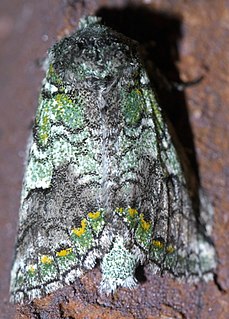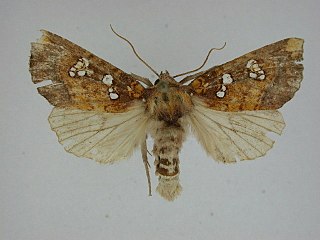Condica charada is a species of moth in the family Noctuidae. It was first described by William Schaus in 1906 and it is found in North America.
Litodonta aonides is a species of moth in the family Notodontidae. It was first described by Strecker in 1899 and it is found in North America.
Condica begallo is a species of moth in the family Noctuidae. It was first described by William Barnes in 1905 and it is found in North America.
Orthodes noverca is a species of cutworm or dart moth in the family Noctuidae first described by Augustus Radcliffe Grote in 1878. It is found in North America.
Chrysoecia atrolinea is a species of moth in the family Noctuidae. It was first described by William Barnes and James Halliday McDunnough in 1912 and it is found in North America.
Anarta obesula is a species of cutworm or dart moth in the family Noctuidae first described by Smith in 1904. It is found in North America.

Litodonta hydromeli, or Harvey's prominent moth, is a species of moth in the family Notodontidae. It was first described by Leon F. Harvey in 1876 and it is found in North America.
Azenia virida is a species of moth in the family Noctuidae. It was first described by William Barnes and James Halliday McDunnough in 1916 and it is found in North America.
Sympistis sectiloides is a species of moth in the family Noctuidae. It was first described by William Barnes and James Halliday McDunnough in 1913 and it is found in North America.
Gonodonta incurva is a species of fruit-piercing moth in the family Erebidae. It is found in North America.
Lacinipolia spiculosa is a species of cutworm or dart moth in the family Noctuidae. It is found in North America.

Paectes pygmaea, the pygmy paectes, is a species of owlet moths, etc. in the family Euteliidae. It is found in North America.
Nystalea eutalanta, or Dyar's tropical prominent moth, is a species of moth in the family Notodontidae. It was first described by Harrison Gray Dyar Jr. in 1921 and it is found in North America.
Unciella flagrantis is a species of owlet moth in the family Noctuidae. It is found in North America.
Proxenus mindara, the rough-skinned cutworm moth, is a species of cutworm or dart moth in the family Noctuidae. It was first described by William Barnes and James Halliday McDunnough in 1913 and it is found in North America.
Lineostriastiria hutsoni is a species of owlet moth in the family Noctuidae. It is found in North America.
Caradrina beta is a species of cutworm or dart moth in the family Noctuidae first described by William Barnes and Foster Hendrickson Benjamin in 1926. It is found in North America.
Lineostriastiria olivalis is a species of moth in the family Noctuidae. It was first described by William Barnes and James Halliday McDunnough in 1916 and it is found in North America.

Papaipema rutila, the mayapple borer moth, is a species of cutworm or dart moth in the family Noctuidae. It is found in North America.
Cucullia pulla is a species of moth in the family Noctuidae. It was first described by Augustus Radcliffe Grote in 1881 and it is found in North America.


